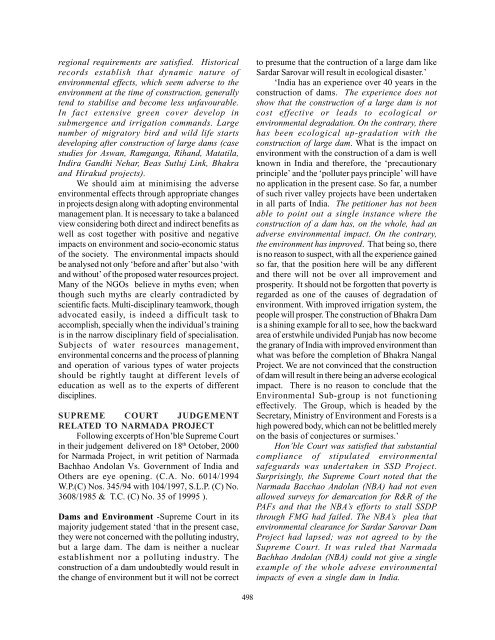Accepted Papers - 3.pdf - UNESCO
Accepted Papers - 3.pdf - UNESCO
Accepted Papers - 3.pdf - UNESCO
You also want an ePaper? Increase the reach of your titles
YUMPU automatically turns print PDFs into web optimized ePapers that Google loves.
egional requirements are satisfied. Historical<br />
records establish that dynamic nature of<br />
environmental effects, which seem adverse to the<br />
environment at the time of construction, generally<br />
tend to stabilise and become less unfavourable.<br />
In fact extensive green cover develop in<br />
submergence and irrigation commands. Large<br />
number of migratory bird and wild life starts<br />
developing after construction of large dams (case<br />
studies for Aswan, Ramganga, Rihand, Matatila,<br />
Indira Gandhi Nehar, Beas Sutluj Link, Bhakra<br />
and Hirakud projects).<br />
We should aim at minimising the adverse<br />
environmental effects through appropriate changes<br />
in projects design along with adopting environmental<br />
management plan. It is necessary to take a balanced<br />
view considering both direct and indirect benefits as<br />
well as cost together with positive and negative<br />
impacts on environment and socio-economic status<br />
of the society. The environmental impacts should<br />
be analysed not only ‘before and after’ but also ‘with<br />
and without’ of the proposed water resources project.<br />
Many of the NGOs believe in myths even; when<br />
though such myths are clearly contradicted by<br />
scientific facts. Multi-disciplinary teamwork, though<br />
advocated easily, is indeed a difficult task to<br />
accomplish, specially when the individual’s training<br />
is in the narrow disciplinary field of specialisation.<br />
Subjects of water resources management,<br />
environmental concerns and the process of planning<br />
and operation of various types of water projects<br />
should be rightly taught at different levels of<br />
education as well as to the experts of different<br />
disciplines.<br />
SUPREME COURT JUDGEMENT<br />
RELATED TO NARMADA PROJECT<br />
Following excerpts of Hon’ble Supreme Court<br />
in their judgement delivered on 18 th October, 2000<br />
for Narmada Project, in writ petition of Narmada<br />
Bachhao Andolan Vs. Government of India and<br />
Others are eye opening. (C.A. No. 6014/1994<br />
W.P.(C) Nos. 345/94 with 104/1997, S.L.P. (C) No.<br />
3608/1985 & T.C. (C) No. 35 of 19995 ).<br />
Dams and Environment -Supreme Court in its<br />
majority judgement stated ‘that in the present case,<br />
they were not concerned with the polluting industry,<br />
but a large dam. The dam is neither a nuclear<br />
establishment nor a polluting industry. The<br />
construction of a dam undoubtedly would result in<br />
the change of environment but it will not be correct<br />
498<br />
to presume that the contruction of a large dam like<br />
Sardar Sarovar will result in ecological disaster.’<br />
‘India has an experience over 40 years in the<br />
construction of dams. The experience does not<br />
show that the construction of a large dam is not<br />
cost effective or leads to ecological or<br />
environmental degradation. On the contrary, there<br />
has been ecological up-gradation with the<br />
construction of large dam. What is the impact on<br />
environment with the construction of a dam is well<br />
known in India and therefore, the ‘precautionary<br />
principle’ and the ‘polluter pays principle’ will have<br />
no application in the present case. So far, a number<br />
of such river valley projects have been undertaken<br />
in all parts of India. The petitioner has not been<br />
able to point out a single instance where the<br />
construction of a dam has, on the whole, had an<br />
adverse environmental impact. On the contrary,<br />
the environment has improved. That being so, there<br />
is no reason to suspect, with all the experience gained<br />
so far, that the position here will be any different<br />
and there will not be over all improvement and<br />
prosperity. It should not be forgotten that poverty is<br />
regarded as one of the causes of degradation of<br />
environment. With improved irrigation system, the<br />
people will prosper. The construction of Bhakra Dam<br />
is a shining example for all to see, how the backward<br />
area of erstwhile undivided Punjab has now become<br />
the granary of India with improved environment than<br />
what was before the completion of Bhakra Nangal<br />
Project. We are not convinced that the construction<br />
of dam will result in there being an adverse ecological<br />
impact. There is no reason to conclude that the<br />
Environmental Sub-group is not functioning<br />
effectively. The Group, which is headed by the<br />
Secretary, Ministry of Environment and Forests is a<br />
high powered body, which can not be belittled merely<br />
on the basis of conjectures or surmises.’<br />
Hon’ble Court was satisfied that substantial<br />
compliance of stipulated environmental<br />
safeguards was undertaken in SSD Project.<br />
Surprisingly, the Supreme Court noted that the<br />
Narmada Bacchao Andolan (NBA) had not even<br />
allowed surveys for demarcation for R&R of the<br />
PAFs and that the NBA’s efforts to stall SSDP<br />
through FMG had failed. The NBA’s plea that<br />
environmental clearance for Sardar Sarovar Dam<br />
Project had lapsed; was not agreed to by the<br />
Supreme Court. It was ruled that Narmada<br />
Bachhao Andolan (NBA) could not give a single<br />
example of the whole advese environmental<br />
impacts of even a single dam in India.

















